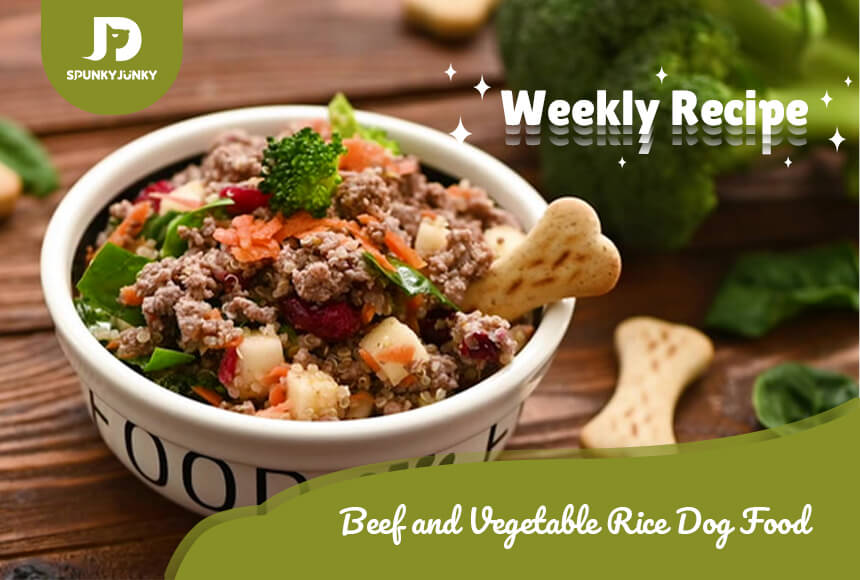It's time for the weekly recipe again. Last week, we introduced the method of making cat food with fish. I wonder if your dog likes it? Today, we bring you a new recipe: Beef and Vegetable Rice. This recipe includes ground beef, vegetables, and rice and is easy to make with simple ingredients. Let's start!
Here's a homemade dog food recipe your furry friend will love!

Ingredients:
● ● 3 pounds of ground beef
● ● 2 cups of uncooked white or brown rice
● ● 1 teaspoon of beef bouillon or beef stock
● ● 1 tablespoon of olive oil
● ● 28 ounces of canned diced tomatoes
● ● 1 ½ cups of fresh carrots, finely chopped or shredded
● ● 2 cups of fresh broccoli, finely chopped or shredded
● ● 2 cups of sweet potato, peeled and finely chopped
● ● 2 cups of fresh spinach, chopped

Instructions:
- 1. Start by making the flavored rice. Use 1 cup rice to 2 cups water with beef bouillon or beef stock. You can scale up or down depending on your dog's needs. Follow the instructions on your rice package for cooking time. Once done, set it aside.
- 2. Brown and crumble the 3 lbs of ground beef in a large skillet over medium-high heat. Once cooked, place the beef and its drippings in a large bowl.
- 3. Chop, shred or process all the veggies. If your dog is a small breed, finely shred the veggies in a food processor. Otherwise, you can use a knife or a box grater. Briefly saute the carrots, broccoli, and sweet potato in a large pot until they are slightly soft for a few minutes over medium heat. Add them to the large bowl with the beef.
- 4. Add the canned diced tomatoes, olive oil, and fresh spinach to the bowl. Mix well with a large spatula.
- 5. Add the cooked rice to the bowl and mix everything. Allow it to cool before serving it to your dog.
TIPS:
- ● If you want to give your dog some added nutrients, try substituting some rice with quinoa or barley. These grains are great sources of protein and fiber and can be a healthy addition to your dog's diet.
- ● When browning the ground beef, use lean beef or turkey to reduce the fat content. You can also try substituting ground beef with ground chicken or turkey for a lower-calorie option.
- ● To make the veggies more digestible for your dog, try lightly steaming them before adding them to the bowl. This can help break down the tough fibers and make the nutrients more available for your dog to absorb.
- ● Tomatoes are a great source of lycopene, which is an antioxidant that can help protect your dog's cells from damage. However, if your dog has kidney problems or a history of bladder stones, you should avoid feeding them tomatoes as they can be high in oxalates.

Storage
If you want to make sure your dog is eating fresh and healthy food, freezer bags are a great option for storing their food. To determine how much food your dog needs, calculate their daily calorie needs based on their size and activity level, and portion out several days' worth of food into individual freezer bags.
For example, if you have a puppy, calculate the number of calories they need each day and allocate a 5-day supply of food. After you've filled each bag with the right amount of food, flatten the bags and place them in an airtight container or larger ziplock bag in the freezer.
When it's time for your furry friend to eat, just pop out a freezer bag. Once thawed, remove ⅕ from the bag daily to ensure your dog is getting the right amount of food.
Using freezer bags to store your dog's food is not only convenient but helps keep their food fresh and safe. So next time you're preparing dog food, try using freezer bags as a hassle-free storage solution.
**Attention**
This homemade dog food recipe is packed with healthy ingredients that provide a balanced and nutritious meal for your dog. It's also a great alternative to store-bought dog food, which often contains additives and preservatives that can harm your dog's health.
Consult with your veterinarian before changing your dog's diet, especially if they have any underlying health issues. Your vet can also help you determine the right portion sizes for your furry friend based on age, weight, and activity level.
Enjoy making this tasty and healthy recipe for your furry friend!






